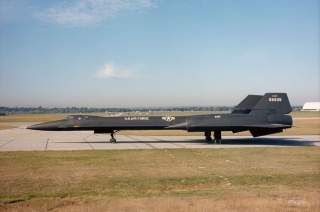The CIA's Very Own SR-71 Spyplane: Check Out the Lockheed A-12
It was amazing.
The Black Shield flights proved valuable, but also suggested it’s a good thing the A-12s were never assigned for overflights of the Soviet Union, which was defended by more advanced surface-to-air missiles and interceptors.
Arguably few aircraft are quite as iconic as the striking-looking SR-71 Blackbird spy plane, renowned for its ability to cruise at three times the speed of sound so as to outrun enemy surface-to-air missiles.
(This first appeared several weeks ago.)
But the Blackbird’s was actually an enlarged evolution of the Lockheed A-12, designed for service with the Central Intelligence Agency. The single-seat A-12 could fly slightly faster and higher, but it was doomed to be replaced by its heavier Air Force spinoff.
By the late 1950s, aviation engineers knew that new Soviet surface-to-air missiles could effectively threaten high-altitude U-2 spy plane overflights of the Soviet Union. This was dramatically illustrated by the shoot down of Gary Power’s U-2 in 1960 over the Soviet Union, which triggering a humiliating political crisis. A second U-2 was shot down during the Cuban Missile Crisis—an event which could have sparked a global nuclear war.
Engineers in Lockheed’s Skunk Work’s facility worked on a U-2 successor using new survivability strategies: sustained supersonic cruising speeds to outrun missiles, electronic warfare systems to suppress their guidance systems, and a stealth-optimized airframe incorporating radar-absorbent materials to decrease the range at which the spy plane could be detected.
Designer Kelly Johnson went through eleven concepts for its “Archangel” spy plane before settling on the twelfth, the A-12—later codenamed “Oxcart” by the CIA, and nicknamed “Cygnus” by its pilots. The last iteration added “chines”—thin blade-like protrusions from the sides of the jet that reduced its radar profile and coincidentally improved its lift.
The A-12’s airframe needed to withstand extremely high temperatures for prolonged periods so the Oxcart was built out of super-hard titanium. The Soviet Union was the chief global supplier of titanium, so the CIA used shell companies purchased the rare metal from the country it intended to spy upon. However, the hard metal proved extremely difficult to work or shape into curved surfaces, requiring the development of new drill bits and hybrid manufacturing processes.
The spy plane undertook its first two flights in April 1962 at Groom Lake—better known as Area 51—initially using less powerful J75 turbojets. Lockheed built only twelve of the super-secret stealth jets, plus a lone J75-powered two-seat trainer named “Titanium Goose” and two two-seat M-21 drone carriers. The aircraft were piloted by sixteen “demilitarized” Air Force pilots who made it through an astronaut-style screening process.
The M-21 carried supersonic D-21 drones on its back which themselves clearly took after aspects of the A-12 itself. However, on a fourth test-run in 1966, a D-21 fatally collided with its M-21 mothership. Both crew ejected, but flight engineer drowned awaiting rescue. Four more A-12s were lost in accidents, killing two more pilots.
Spy Jet Showdown: A-12 versus SR-71 Blackbird
Evolving technology and political circumstances both conspired to undermine the A-12’s relevance. Following the Gary Powers fiasco, Washington finally decided to cease illegal overflights of Soviet territory, killing much of the A-12’s raison d’etre. After all, new CIA-operated Corona spy satellites could obtain similar photo-intelligence—though not always as quickly, and with lower resolution—but crucially, without putting pilots at risk or heightening Cold War tensions.
Meanwhile, the Air Force also was interested in the A-12’s airframe—and ordered develop an interceptor variant called the YF-12, as well as an unclassified SR-71 Blackbird two-seat strategic reconnaissance variant with side-looking cameras, enabling gathering of photo-intelligence without having to fly over interdicted airspace. The SR-71 was six feet longer than the A-12 and could carry 20,000 pounds more equipment and fuel.
Even LBJ’s guns-and-butter economy could not accommodate both highly-expensive spy planes, so in November 12, 1967 the CIA and Air Force models flew-off in a competitive evaluation codenamed “Nice Girl.” Testers reported the A-12 was slightly stealthier, could fly five percent higher at ninety thousand feet and a bit faster with maximum speed of 2,212 miles per hour compared to the Blackbird’s 2,193 mph.
But the evaluators felt these incremental performance improvements were greatly outweighed by the Blackbird’s ability to carry multiple reconnaissance systems at once, as well as electronic countermeasures more likely to keep it alives. The Blackbird could also fly a few hundred miles further with its heavier fuel load.
The A-12 would be retired just seven months later.
Prior to its retirement, however, between May 1967 and March 1968 the CIA deployed three A-12s to Okinawa, Japan where they flew twenty-nine spy missions over Vietnam, North Korea, and Cambodia. These missions were greatly valued by the Johnson administration, revealing that North Vietnam had not deployed surface-to-surface missiles as had been feared, as well as locating the hijacked U.S spy ship USS Pueblo in North Korea. However, the A-12’s stealth characteristics were proven to be inadequate versus Soviet radars. On one mission over Hanoi, an A-12 was damaged by missile fragments after being chased by six S-75 missiles. You can read more about Operation Black Shield in a companion article.
The Black Shield flights proved valuable, but also suggested it’s a good thing the A-12s were never assigned for overflights of the Soviet Union, which was defended by more advanced surface-to-air missiles and interceptors.
Today, the surviving A-12 airframe can be seen in exhibitions across the country, including the CIA headquarters in Langley, Virginia and onboard the USS Intrepid museum carrier at New York City.
Sébastien Roblin holds a master’s degree in conflict resolution from Georgetown University and served as a university instructor for the Peace Corps in China. He has also worked in education, editing, and refugee resettlement in France and the United States. He currently writes on security and military history for War Is Boring.
Image: U.S. Department of Defense

